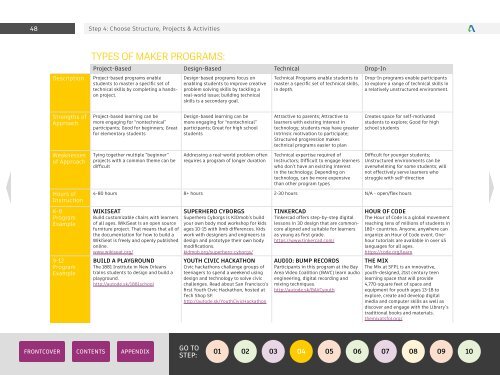A STEP-BY-STEP GUIDE TO LAUNCHING YOUR FIRST MAKER PROGRAM
Maker-Program-Starter-Kit
Maker-Program-Starter-Kit
Create successful ePaper yourself
Turn your PDF publications into a flip-book with our unique Google optimized e-Paper software.
48<br />
Step 4: Choose Structure, Projects & Activities<br />
Description<br />
TYPES OF <strong>MAKER</strong> <strong>PROGRAM</strong>S:<br />
Project-Based Design-Based Technical Drop-In<br />
Project-based programs enable<br />
students to master a specific set of<br />
technical skills by completing a handson<br />
project.<br />
Design-based programs focus on<br />
enabling students to improve creative<br />
problem solving skills by tackling a<br />
real-world issue; building technical<br />
skills is a secondary goal.<br />
Technical Programs enable students to<br />
master a specific set of technical skills,<br />
in depth.<br />
Drop-In programs enable participants<br />
to explore a range of technical skills in<br />
a relatively unstructured environment.<br />
Strengths of<br />
Approach<br />
Weaknesses<br />
of Approach<br />
Hours of<br />
Instruction<br />
Project-based learning can be<br />
more engaging for “nontechnical”<br />
participants; Good for beginners; Great<br />
for elementary students<br />
Tying together multiple “beginner”<br />
projects with a common theme can be<br />
difficult<br />
Design-based learning can be<br />
more engaging for “nontechnical”<br />
participants; Great for high school<br />
students<br />
Addressing a real-world problem often<br />
requires a program of longer duration<br />
Attractive to parents; Attractive to<br />
learners with existing interest in<br />
technology; students may have greater<br />
intrinsic motivation to participate;<br />
Structured progression makes<br />
technical programs easier to plan<br />
Technical expertise required of<br />
instructors; Difficult to engage learners<br />
who don’t have an existing interest<br />
in the technology; Depending on<br />
technology, can be more expensive<br />
than other program types<br />
Creates space for self-motivated<br />
students to explore; Good for high<br />
school students<br />
Difficult for younger students;<br />
Unstructured environments can be<br />
overwhelming for some students; will<br />
not effectively serve learners who<br />
struggle with self-direction<br />
4-80 hours 8+ hours 2-30 hours N/A - open/flex hours<br />
K-8<br />
Program<br />
Example<br />
WIKISEAT<br />
Build customizable chairs with learners<br />
of all ages. WikiSeat is an open source<br />
furniture project. That means that all of<br />
the documentation for how to build a<br />
WikiSeat is freely and openly published<br />
online.<br />
www.wikiseat.org/<br />
BUILD A PLAYGROUND<br />
The 1881 Institute in New Orleans<br />
trains students to design and build a<br />
playground.<br />
http://autode.sk/1881school<br />
SUPERHERO CYBORGS<br />
Superhero Cyborgs is KIDmob’s build<br />
your own body mod workshop for kids<br />
ages 10-15 with limb differences. Kids<br />
work with designers and engineers to<br />
design and prototype their own body<br />
modifications.<br />
kidmob.org/superhero-cyborgs/<br />
TINKERCAD<br />
Tinkercad offers step-by-step digital<br />
lessons in 3D design that are commoncore<br />
aligned and suitable for learners<br />
as young as first grade.<br />
https://www.tinkercad.com/<br />
HOUR OF CODE<br />
The Hour of Code is a global movement<br />
reaching tens of millions of students in<br />
180+ countries. Anyone, anywhere can<br />
organize an Hour of Code event. Onehour<br />
tutorials are available in over 45<br />
languages for all ages.<br />
https://code.org/learn<br />
THE MIX<br />
The Mix at SFPL is an innovative,<br />
youth-designed, 21st century teen<br />
learning space that will provide<br />
4,770-square feet of space and<br />
equipment for youth ages 13-18 to<br />
explore, create and develop digital<br />
media and computer skills as well as<br />
discover and engage with the Library’s<br />
traditional books and materials.<br />
themixatsfpl.org/<br />
9-12<br />
Program<br />
Example<br />
YOUTH CIVIC HACKATHON<br />
Civic hackathons challenge groups of<br />
teenagers to spend a weekend using<br />
design and technology to solve civic<br />
challenges. Read about San Francisco’s<br />
first Youth Civic Hackathon, hosted at<br />
Tech Shop SF:<br />
http://autode.sk/YouthCivicHackathon<br />
AUDIO: BUMP RECORDS<br />
Participants in this program at the Bay<br />
Area Video Coalition (BAVC) learn audio<br />
engineering, digital recording and<br />
mixing techniques.<br />
http://autode.sk/BAVCyouth<br />
GO <strong>TO</strong><br />
<strong>STEP</strong>:


